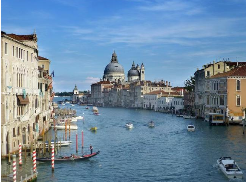Entertainment science Western architectural style
3 min read
NO. 1 Ancient Roman architecture is a pearl in the treasure house of architectural art. It carries the architectural style of ancient Greek civilization, highlights the characteristics of the Mediterranean region, and is a development of ancient Greek architecture. The structural characteristics of Roman architecture: arch structure, arch structure, truss structure, beam and column system, fountain structure, lintel structure, arch structure, cross vault structure, multi-vault structure. There were many types of ancient Roman architecture, including religious buildings such as the Pantheon in Rome and the Temple of the Sun in Baalbek, as well as palaces, theaters, gladiators, baths and public buildings such as plazas and Basilica.
The 4th — 15th century AD.
Byzantine architecture is an art form of architecture with a Christian background. The building has a distinct religious character and its prominent feature is the circular shape of the roof. “Byzantium” was originally a colony of ancient Greece. In 395 AD, the prominent Roman Empire split into two countries, which was born in this period of the Eastern Roman Empire of an architectural culture. Hagia Sophia is a typical Byzantine building.
Gothic style.
NO. 3
The 6th — 16th century Gothic architecture was an architectural style that flourished at the height and end of the Middle Ages. It developed from Romanesque architecture and was inherited by Renaissance architecture. Gothic architecture is characterized by high spires, pointed arches, large Windows, and flowered panes of biblical stories. In the design, the pointed ribbed vault, flying buttresses and slender beam columns are used to create a light and slender sense of flying. With outstanding architectural skills, it expresses the strong emotions of mystery, pathos and sublimity, which has a great influence on other arts of later generations. The most famous Gothic buildings include the Cathedral of Notre Dame in Russia, Milan Cathedral in Italy, Cologne Cathedral in Germany, Westminster Cathedral in Britain, Notre Dame Cathedral in Paris in France, etc. Renaissance.
NO. 4
14th — 17th century AD.
Renaissance architecture is a kind of architectural style after Gothic architecture in the history of European architecture. Originated in Italy in the 15th century, and then spread to other parts of Europe, forming with their own characteristics of Renaissance architecture.
The most obvious characteristic of Renaissance architecture is that it abandons the Gothic architectural style of the Middle Ages and readopts the columnar composition elements of Ancient Greece and Rome in religious and secular architecture. On the one hand, they adopt the classical columnar style, on the other hand, they are flexible and bold in innovation, and even integrate the architectural style of various regions with the classical columnar style.
NO. 5
Baroque & Rococo.
17th-18th centuries.
Baroque architecture is an architectural and decorative style developed on the basis of Italian Renaissance architecture in the 17th and 18th centuries. Bohemian, extreme luxury is the main characteristics of Baroque architecture, in the Baroque buildings decorated with fresco sculptures. In Italian, Baroque means “misshapen pearl.” This kind of architecture is characterized by its emphasis on interior decoration. All the curves are taken, often interspersed with curved surfaces and elliptic Spaces. An attempt to show off people’s vision in a rich and varied style, with exaggerated patterns. Important buildings of this period include St. Peter’s Basilica, Paris Palace of Versais, Place Louis XIV, and Place de la Victory. The Rococo style of architecture originated in France and became popular in Europe in the 1720s. It developed on the basis of Baroque architecture and was mainly displayed in interior decoration. The basic characteristics of Rococo style are delicate and charming, gorgeous and delicate, sweet and tender, trivial. Like to use arc and S-shaped lines, especially love to use shells, whirlpool, rocks as decorative themes, roll grass comfortable flowers, lingering winding, linked together. Taking the decline of European feudal aristocratic culture as the background, it shows the decadent and flashy aesthetic ideal and ideological mood of the declining aristocratic class. They could not stand the serious reason of classicism and the clamour of Baroque, and pursued beauty and leisure.






